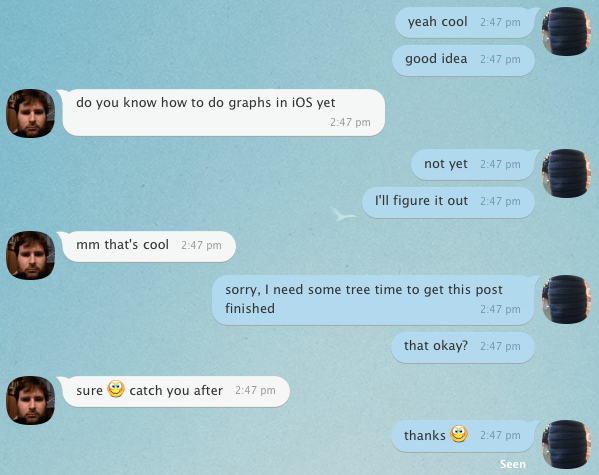If you work in a remote team, one of the aspects you quickly notice is the importance of communication. Finding the best ways to communicate with your team is imperative when you're not working face-to-face, because you're missing most—if not all—of the context of each person's situation.
If you're in an office with your teammates, for instance, you'll notice if someone is especially quiet and withdrawn. And if that's a common behavior pattern, you'll know that it's a tip-off that they didn't sleep well last night and need some space or that they're especially stressed and could use a chat to share their concerns.
You'll also notice details like noise levels in the office or distracting roadworks noise outside. You'll be able to tell when someone's really focused on their work versus when they're open to interruptions.
As humans, we're great at picking up on these signals. We practice this every day in our interactions and use people's body language and tone of voice to inform the way we communicate with them.
But in a remote team, you lose a lot of that context, so you need to find ways to make up for it. Let's take a look at some ways to build strong connections with your teammates when they're far away.
Building Rapport Remotely
When you start a new job in a remote team, it can feel very strange. Although it might be less confronting than working in a new office full of people you don't know, it can also be more isolating, as you don't have an easy way to get to know everyone quickly—especially those you don't work with directly.
Eventually, you'll make the rounds and have some interaction with everyone, and perhaps even meet them in person at a company retreat like Zapier holds every few months. But how do you go about building a rapport with people you've never really met?
Let's start with some standard methods for building rapport, and look at how we can apply them to a remote working situation.
Robin Dreeke is the founder of People Formula, former Head of the FBI's Behavioral Analysis Program, and author of It's Not All About Me: Ten Techniques for Building Quick Rapport With Anyone. In his book, Dreeke explains some of the most basic ways to build rapport with others, including smiling, tilting your chin lower so you're not looking down on them, matching their handshake strength, and slowing down your speech so you come across as being more credible.
All good tips, but not very useful in a remote setting. So what can we apply to a remote situation to help us build strong relationships with our teammates? Well, Dreeke suggests a few things that we can use.
First, Dreeke points out that meeting someone new can be overwhelming when you have no time constraint on your conversation. Because we're wired to look for threats in any new situation, our first reaction to meeting someone is to be wary of them until we start building up some rapport. Establishing an artificial time constraint can help ease the pressure of a conversation with someone new, according to Dreeke.
If you're setting up phone or video calls to meet your new teammates, try setting a time limit of 15 minutes.
Another tip from Dreeke is to validate others by listening to them and suspending your ego. "True validation coupled with ego suspension means that you have no story to offer, that you are there simply to hear theirs," he writes.
We love to talk about ourselves, especially to good listeners, but this means we're often ready to respond with our own related stories when our conversation partner finishes talking. According to Dreeke, ego suspension means putting aside our own desires to contribute to the conversation and instead asking short, open questions like how, when, and why.
Studies have shown that listening carefully and asking the person you're talking with to expand on what they're saying will make you more likable and more likely to be chosen for future conversations.
So, in summary:
set a finish time before starting a conversation with someone new
listen without interrupting or sharing your own stories
ask short, open questions
Relying on Text the Right Way
Your team might rely on tools like Skype or Zoom for video and voice chats, which will give you a chance to use those rapport-building strategies we just discussed. Voice and video calls can help you feel more in touch with your team and avoid the issues of asynchronous communication like time lags or misunderstandings.
But you'll likely spend a lot of your day communicating with text. Whether it's in Slack, Basecamp shared documents, emails, or GitHub issues, text tends to be the most convenient way to keep in touch with your teammates without interrupting them.
Related: "The Best Team Chat App for Your Company"
Effective written communication is such an important part of remote working that it's often part of what remote companies look for when hiring. For instance, Automattic Happiness Engineer Andrew Spittle shares:
Text is our predominant communication mode and we look for strong writing skills in applicants. On the support side that’s key since text is not just how we communicate with customers but also with each other. Our interview process is all done through text chats, too, as a way to evaluate that ability.
In a remote setting, you need to be able to get your point across clearly and simply, show empathy and understanding, and be efficient to avoid wasted time, since you may be waiting across timezones for your team to reply anyway.
Here are three suggestions for connecting with remote team members through text:
1. Stay Up to Date
When your teammates are working on the other side of the world, you get used to waking up or coming back from lunch to a full inbox and messages flowing in from your team chat, shared documents, and various other places. This can be overwhelming, so finding ways to keep on top of what's going on is imperative for communicating efficiently with each other.
The distributed Stripe team shares most internal emails, which means everyone has a very full inbox to work through daily. With over 400 email lists in the company, there's a lot to organize at Stripe.
One of the approaches Stripe takes for scaling transparent emails is to create archive lists where otherwise irrelevant emails are CC'd to. This means if you're setting up a meeting with someone you don't have to flood everyone's inboxes with your back-and-forth emails, but later on, everyone has access to that information if they need it. Here's how Greg Brockman, Chairman and CTO of OpenAI and former Stripe CTO explains it:
The goal isn't to share things that would otherwise be secret: it's to unlock the wealth of information that would otherwise be accidentally locked up in a few people's inboxes. In general, if you are debating including an archive list, you should include it.
(Buffer also uses a transparent email process. You can read about how it works on the Buffer Open blog.)
2. Remember Hanlon's Razor
A razor is a concept used in philosophy to help us strip away possible explanations (hence the name) for a phenomenon. Hanlon's razor refers to the idea that we should always assume ignorance before malice. That is, if someone does something wrong, don't assume they purposely meant to hurt you. It's just as likely (perhaps more so) that they simply made a mistake.
This is especially important in situations where you're missing context. If you're communicating via text with co-workers who are multiple time zones away, try to always assume ignorance before malice if you have a misunderstanding.
In my own experience, this has happened several times. When I worked remotely for Buffer, I would often jump on a call with Leo to discuss something we'd disagreed about, only to realize we weren't on the same page at all, and it had all been a misunderstanding.
Asserting Yourself When Needed
Perhaps the hardest, yet most obvious, way to compensate for the lack of context in remote communication is to be more forward and open than you normally would. As I mentioned in my example earlier, working with someone in an office makes it easier to pick up on their mood and know when they need some time alone. When you work remotely, you're going to bug people by chatting to them when they're not in the mood—it's unavoidable. Being respectful of others is just harder when you have less information to inform your decisions.
To cut down on that problem, we need to find ways to share that context explicitly with each other. A good way to go about this is to set up rules ahead of time.
Here's an example from my own experience: my co-founder Josh Sharp and I use Viber to communicate throughout the day. Sometimes it's a quick message here and there about grabbing some lunch or heading out for a meeting. Other times, we have real-time chats for hours about our work. Because Viber is our "always on" channel for communicating, we have to explicitly remove ourselves from being available if we need uninterrupted work time. To avoid anyone getting offended by a frustrated request that they shut up for a while, we came up with a code word.
"Tree time" is what we call our uninterrupted work time. I don't remember where the name came from now, but I think it had something to do with a hypothetical scenario where one of us runs up a tree to get away from the other… Regardless, this is now our code word. If one of us asks the other for some "tree time", it means "don't get offended, but I'm finding it hard to concentrate and I really need some uninterrupted time to focus on what I'm doing."

Because we set up this rule ahead of time, we both know it's an option. Anytime we feel the need for some peace and quiet while we work, we know we can fall back on tree time without having to explain ourselves or worry about offending the other person because we don't want to chat right now.
Being open about what you need can be really hard. Most of us aren't used to being so upfront with our teammates. But keep in mind all the information you have about how you feel and your current needs that your teammates don't have.
It's up to you to fill in that gap so they can communicate with you in the best way.
Another good example of setting this up in advance is what the Basecamp team did when it introduced phone support. At first, the support team was wary of adding the extra pressures of phone support to their workload. How do you do phone support when you work remotely from cafés?
Basecamp didn't want the support team to lose the benefits that come with remote working, so they set up some guidelines ahead of time. One is that team members can take breaks to work outside, in cafés, or just away from the phones, and the rest of the team will cover for them. Making this rule in advance means team members know it's an option and can ask for it when they need some space.
Experiment with different options to find what works best, but remember the most important lesson: Find a way to share the context of your situation with your teammates. They need all the information you can give them to work with you in the best way they can.




